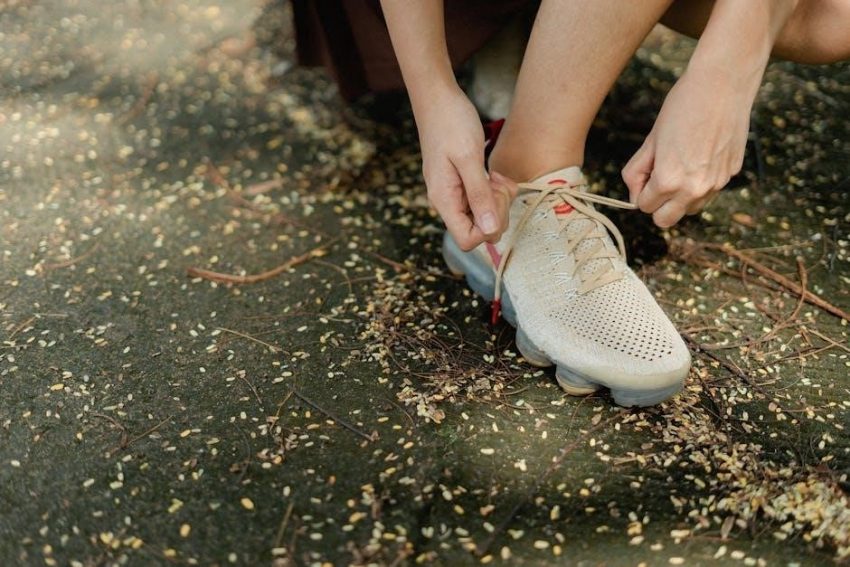Knot tying is a fundamental skill offering versatility and reliability across various activities. From securing loads to creating shelter, knots provide essential solutions for everyday tasks and outdoor adventures, ensuring safety and security in countless situations.
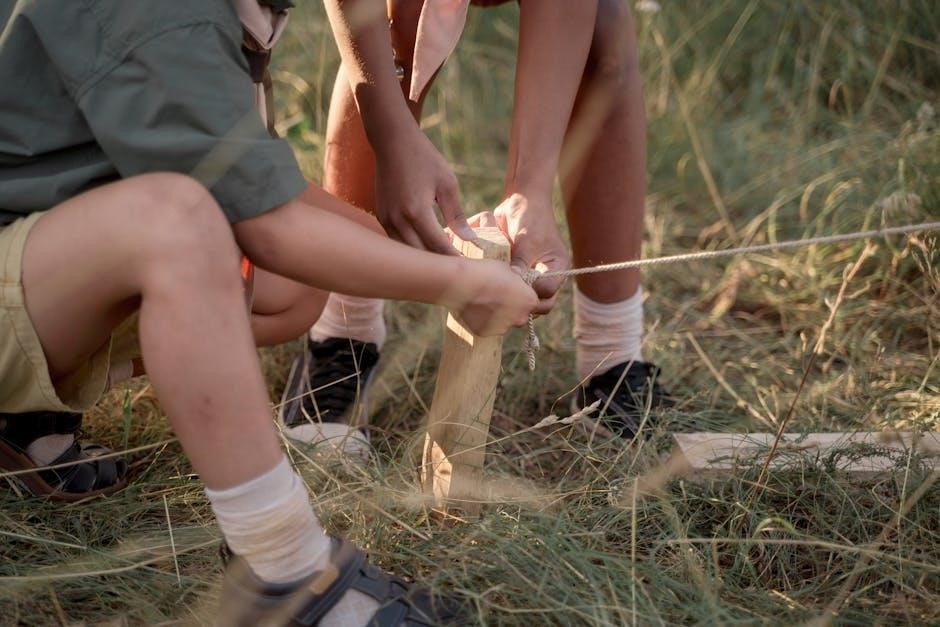
1.1 The Importance of Knot Tying
Knot tying is an essential skill that offers universal applications across various industries and everyday life. Whether for camping, sailing, climbing, or rescue operations, mastering knots ensures safety and reliability. A well-tied knot can prevent accidents, secure loads, and provide critical support in emergencies. Its versatility makes it indispensable for professionals and enthusiasts alike, enabling efficient problem-solving in diverse situations. Learning knots fosters confidence and preparedness, proving invaluable in both routine tasks and extreme conditions. The ability to tie knots correctly is not just a practical skill but also a cornerstone of survival and efficiency in countless scenarios.

1.2 Brief History of Knots
Knots have been integral to human civilization for thousands of years, serving as tools for survival, trade, and exploration. Early evidence of knot use dates back to prehistoric times, with primitive cultures employing knots for hunting, fishing, and constructing shelter. Ancient civilizations, such as the Egyptians, Greeks, and Inuit, developed intricate knotting techniques for both practical and ceremonial purposes. The evolution of sailing and navigation further elevated the importance of knots, as they became essential for securing ships and rigging. Over centuries, knots have been refined and adapted to meet the demands of various industries, from climbing to rescue operations; Today, knots remain a cornerstone of modern life, blending tradition with innovation to address contemporary challenges.
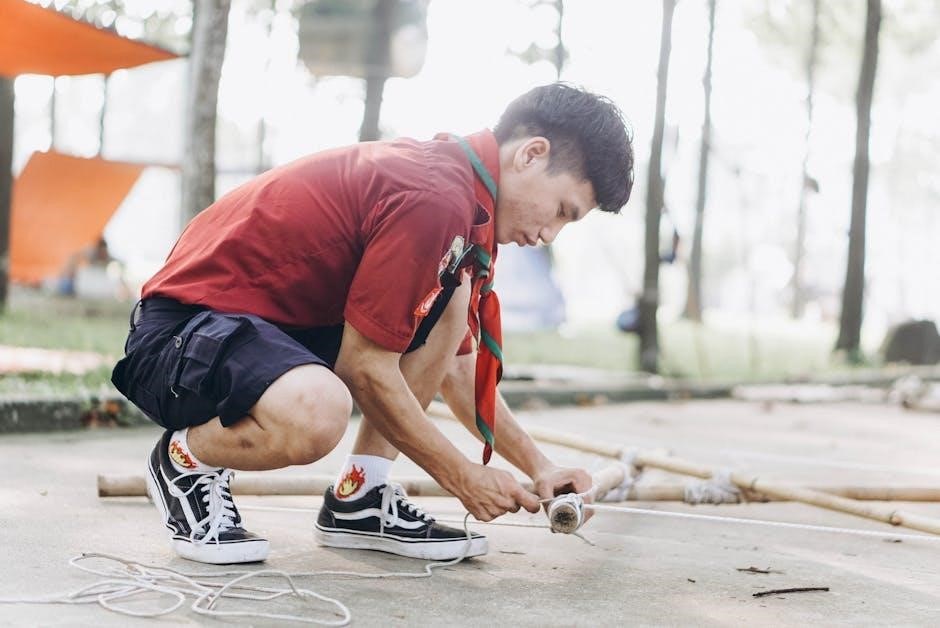
A Comprehensive Guide to Knot Tying
Knot tying offers a diverse array of techniques essential for various applications. This guide covers foundational skills, materials, and terminology to master effective knot tying for any situation.
2.1 Essential Materials Needed for Knot Tying
Knot tying requires minimal equipment but the right materials. A sturdy rope, cord, or string is the foundation. Natural fibers like cotton or hemp and synthetic options like nylon or polyester are popular choices. The material’s flexibility, strength, and durability determine its suitability for specific knots. For practice, a smooth, consistent rope is ideal to ensure proper grip and ease of handling. Additional tools like a knife for trimming, wax for lubrication, and gloves for grip can enhance efficiency. A flat surface or board for laying out ropes can also aid in mastering complex knots. Choosing the right materials ensures reliability and effectiveness in various applications.
2.2 Basic Knot Tying Concepts
Knot tying begins with understanding the rope’s structure, including the standing part (long, static portion) and the working end (active part used to tie the knot). Key concepts include creating loops, wraps, and twists, which form the foundation of most knots. Friction and tension are critical for securing knots, while proper alignment ensures strength and reliability. Understanding how to manage slack and tighten evenly is essential for consistency. Familiarity with terms like “hitch,” “bend,” and “lashing” helps in identifying knot types. Basic concepts also involve recognizing when a knot is secure and how to adjust or undo it safely. Mastery of these fundamentals builds a solid base for more complex knot tying techniques.
2.3 Common Terms Used in Knot Tying
Understanding key terms is crucial for effective knot tying. The “standing part” refers to the longer, static section of the rope, while the “working end” is the active part used to create the knot. A “loop” is a complete turn in the rope, and a “bight” is a bend or curve. “Twist” describes a rotation of the rope, and “friction” is the resistance that secures the knot. Terms like “hitch,” “bend,” and “lashing” describe specific knot types. “Tension” refers to the tightness of the rope, and “slack” is the loose portion. Familiarity with these terms ensures clear communication and accurate knot construction, making it easier to follow instructions and master various techniques effectively in both practical and creative applications.
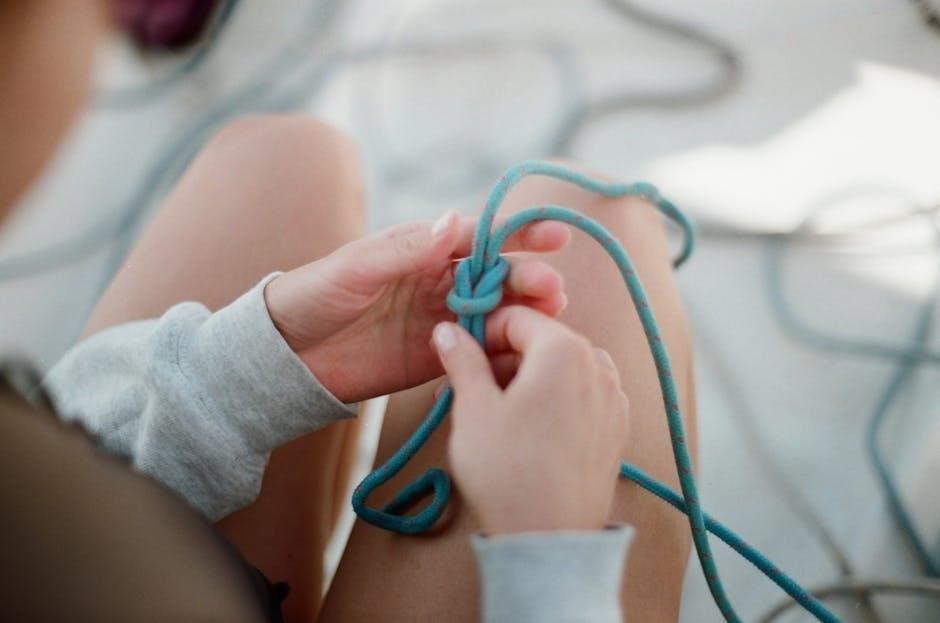
Practical Applications of Knot Tying
Knot tying is essential for camping, sailing, climbing, and rescue operations. It provides reliable solutions for securing loads, creating shelter, and ensuring safety in various environments and emergencies.
3.1 Knots for Camping and Outdoor Activities
Knots are indispensable for camping and outdoor activities, ensuring safety and efficiency. The Square Knot is ideal for securing tent lines, while the Bowline creates reliable loops for hoisting gear. The Sheet Bend joins ropes of different thicknesses, perfect for extending tent guy lines. The Clove Hitch is excellent for securing tarps or adjusting load positions. The Timber Hitch helps in dragging logs, and the Prusik Knot is essential for climbing applications. These knots provide the necessary tools to set up camp, secure equipment, and navigate challenging terrain. Mastering them enhances safety and makes outdoor adventures more enjoyable. Whether setting up shelter or navigating trails, the right knot ensures reliability and confidence in the wild.
3.2 Knots for Sailing and Boating
Knots are crucial for sailing and boating, ensuring safety and control on the water. The Bowline Knot creates a secure loop for hoisting sails or rescue operations. The Sheet Bend joins two ropes, ideal for extending docking lines. The Clove Hitch secures lines to posts or rails, while the Reef Knot ties sail edges for reefing. The Rolling Hitch prevents slipping when securing ropes to poles, like towing a boat. These knots are essential for docking, anchoring, and navigating safely. Mastering them ensures reliability in various marine situations, from mooring to emergency responses. Whether sailing or boating, the right knot enhances safety, efficiency, and confidence on the water.
3.3 Knots for Climbing and Rescue Operations
Knots are vital in climbing and rescue operations, where safety and reliability are paramount. The Figure Eight Knot is commonly used to secure climbing harnesses, while the Bowline Knot creates a reliable loop for lifting or hoisting. The Prusik Knot is essential for ascending ropes in rescue scenarios. The Alpine Butterfly Knot connects ropes in the middle, ideal for creating anchors. These knots ensure secure anchor points, facilitate rope ascension, and enable safe lifting of individuals. In rescue operations, the Figure Eight Follow-Through Knot is used for rappelling and lowering. Mastering these knots is critical for climbers and rescuers, providing the confidence and reliability needed in high-stakes situations. Proper knot tying ensures safety, efficiency, and successful outcomes in climbing and rescue missions.
Step-by-Step Instructions for Popular Knots
This section provides clear, easy-to-follow guides for mastering essential knots. Detailed steps ensure proper technique, helping you secure, lift, or join materials effectively in various situations.
4.1 The Square Knot (Reef Knot)
The Square Knot, also known as the Reef Knot, is a simple yet essential knot for securing two ends of a rope together. It is commonly used in camping, sailing, and first aid. To tie it, overlap the two ends, wrap one around the other, and pass it through the loop. Repeat the process with the second end, ensuring it mirrors the first. Tighten firmly to secure. While effective for joining ropes of equal thickness, it may slip under heavy loads or with uneven rope sizes. Regularly checking and tightening is recommended for reliability in critical situations. This knot is a cornerstone of knot tying skills, offering versatility and ease of use across various applications.
4.2 The Bowline Knot
The Bowline Knot is one of the most versatile and reliable knots, known for creating a secure, fixed loop at the end of a rope. Often called the “King of Knots,” it is widely used in sailing, climbing, and rescue operations. To tie a Bowline, form a loop in the rope, pass the working end through it, then around the standing part, and back through the loop. Pull tight to secure. Its key advantage is that it does not slip or jam, even under heavy tension, and it is easy to untie after use. The Bowline is essential for applications requiring a strong, dependable loop, making it a favorite among sailors, climbers, and emergency responders. Mastering this knot is a fundamental skill for anyone serious about knot tying.
4.3 The Sheet Bend Knot
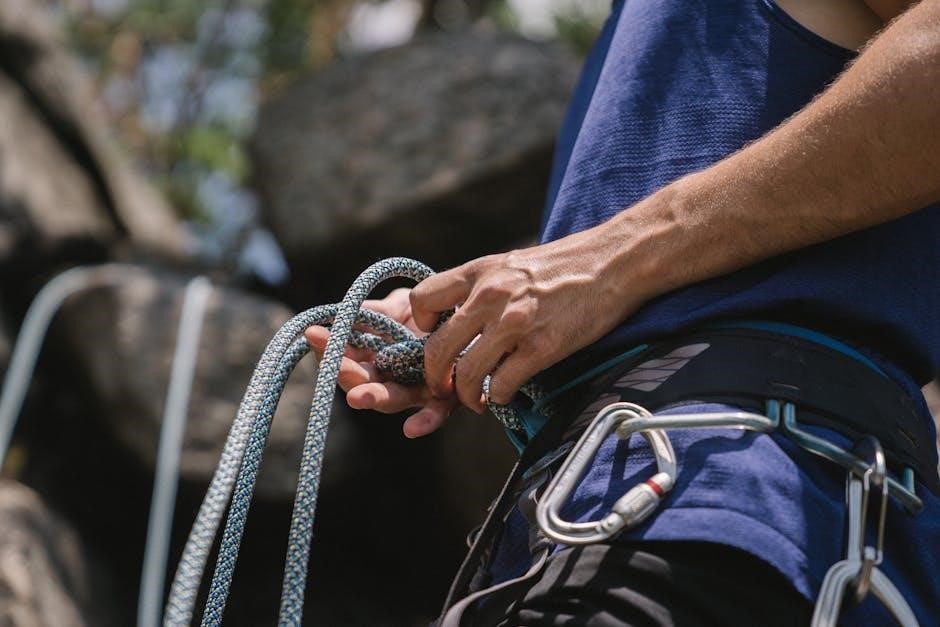
The Sheet Bend Knot is a simple yet effective knot used to join two ropes together, even if they differ in thickness. It is highly versatile and works well in various conditions. To tie it, overlap the ends of the two ropes, form a loop with one rope, and wrap the other rope around it. Pass the second rope under itself and through the loop, then pull tight to secure. This knot is ideal for extending rope length, securing sails, or combining shorter ropes for camping or emergency situations. While it may slip under heavy tension, it can be reinforced with additional turns for greater reliability. The Sheet Bend is a must-know knot for its practicality and ease of use in everyday and outdoor applications.

Advanced Knot Tying Techniques
Advanced knot tying involves mastering intricate patterns, specialized techniques, enhancing precision, and exploring creative applications for various unique situations and challenges for both practical and decorative purposes.

5.1 Loop Knots and Their Variations
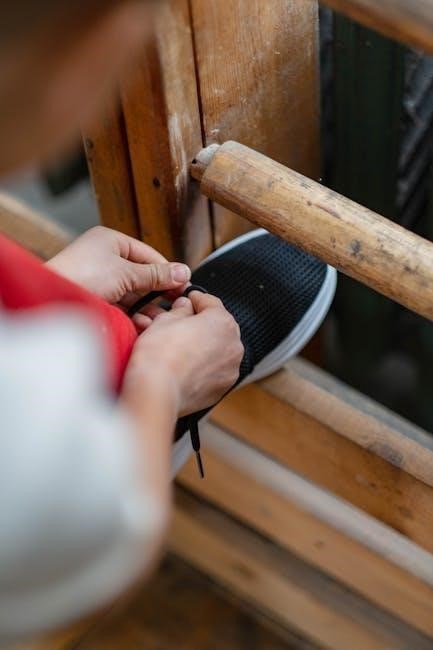
Loop knots are essential for creating secure and reliable loops at the end of a rope, crucial for climbing, sailing, and rescue operations; These knots provide a fixed or adjustable loop, enhancing versatility in various applications. The Bowline knot, for instance, is renowned for its reliability in creating a fixed loop, often used in sailing and rescue scenarios. The Figure Eight knot, also known as the Flemish knot, is another popular loop knot that’s easy to untie even after heavy use. Variations of loop knots offer different advantages, such as the Lark’s Head knot, which is quick to tie and untie, making it ideal for temporary applications. Understanding these knots and their variations is vital for maximizing their effectiveness in diverse situations, ensuring safety and efficiency.

5.2 Decorative Knots for Crafting
Decorative knots add both functionality and aesthetic appeal to various crafting projects. These knots, such as the Monkey’s Fist, Turks Head, and Carrick Bend, are often used in jewelry, home decor, and accessories. They offer a unique way to personalize items while showcasing knot-tying skills. Decorative knots can also be incorporated into macrame, embroidery, and other textile crafts, creating intricate patterns and designs. Additionally, they hold cultural and historical significance, making them a meaningful addition to handmade creations. Mastering decorative knots not only enhances crafting projects but also fosters creativity and appreciation for the art of knot tying. Whether for practical use or artistic expression, decorative knots bring a timeless elegance to any craft.
5.3 Troubleshooting Common Knot Tying Mistakes
When tying knots, common mistakes can lead to weak or unreliable results. One frequent error is incorrect wrapping or tucking, which can cause the knot to slip or fail under tension. Another issue is insufficient tension during tying, resulting in a loose or poorly formed knot. To troubleshoot, practice tying knots slowly and deliberately, ensuring each step is executed correctly. Using a consistent reference, like a guide or video, can help identify and correct errors. Testing knots under light tension before relying on them is also crucial. Patience and repetition are key to mastering knot tying and avoiding frustrating mistakes. By addressing these common pitfalls, you can ensure your knots are strong, reliable, and effective for any situation.
Knot tying is an essential skill with practical applications in various fields. Consistent practice enhances proficiency. Explore advanced techniques and stay updated with the latest methods for mastery.
6.1 Practicing and Mastering Knot Tying Skills
Mastering knot tying requires consistent practice and patience. Start with simple knots and gradually progress to more complex ones. Use high-quality materials to ensure proper technique. Regular repetition helps build muscle memory and improves speed. Focus on understanding the purpose of each knot to enhance retention. Practice in different environments to adapt to varying conditions. Seek feedback from experienced practitioners to refine your skills. Stay consistent, as mastery takes time and dedication. Incorporate knot tying into daily activities or projects to reinforce learning. Celebrate progress and stay motivated to continue improving. With persistence, you’ll become proficient in tying knots efficiently and effectively for any situation.
6.2 Resources for Further Learning
To deepen your understanding and refine your knot-tying skills, explore additional resources such as detailed books, online tutorials, and video guides. Websites like Animated Knots offer step-by-step visual instructions, while YouTube channels provide hands-on demonstrations. Join knot-tying communities or forums to share techniques and learn from experts. Mobile apps like Knot Guide or Pro Knot can serve as handy references. Attend workshops or local meetups to practice with others. Lastly, experiment with different materials and scenarios to apply your knowledge creatively. These resources will help you stay updated and enhance your proficiency in knot tying, ensuring you’re well-prepared for any challenge.
